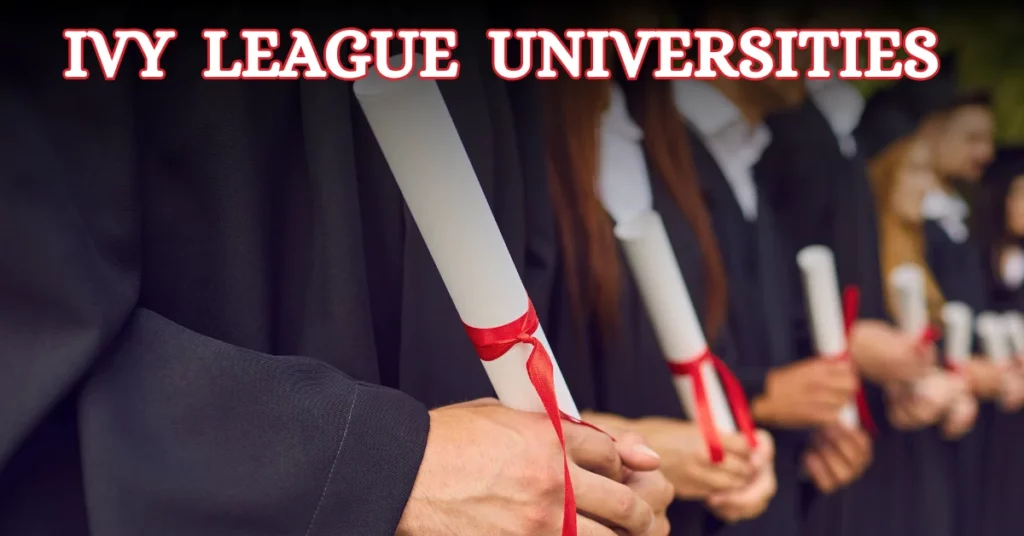
Table of Contents
- What is the Ivy League? Understanding the Significance
- History of Ivy League Universities
- What are the Ivy League colleges’ Characteristics?
- Which are the top 8 Ivy League business schools?
- Ivy League Universities’ Acceptance Rates
- Ivy League Universities Ranking
- How to get into Ivy League colleges?
- Conclusion
- Frequently asked questions
As you search for esteemed educational institutions in the United States, the term “Ivy League” will pique your interest. The Ivy League colleges in the USA is a term that often conjures up images of prestige, privilege, and academic excellence.
However, what exactly defines the Ivy League, and which universities hold the honor of bearing this prestigious label? Furthermore, how do tuition fees for Indian students align with Ivy League colleges? This blog will delve into every aspect of Ivy League schools and answer all your inquiries!
What is the Ivy League? Understanding the Significance
Ivy League universities represent a select group of the most prestigious academic institutions in the United States. These universities are known for their competitive nature, exceptional academic standards, and a reputation for being highly selective in their admissions process. They are often considered elite institutions, offering education of unparalleled quality within the United States.
The term “Ivy League” originally referred to an athletic competition among these universities, primarily located in the northeastern region of the United States.
Ivy League universities consistently rank among the top educational institutions, not only within the United States but also on a global scale. They are renowned for their rigorous admission criteria, and their selection committees maintain exceptionally high standards.
This reputation has persisted since the 1960s and continues to define these institutions. Covering a wide array of academic disciplines, from engineering and the sciences to art, law, and medicine, Ivy League universities are celebrated for their comprehensive offerings.
History of Ivy League Universities
The Ivy League originated as an athletic association comprising eight private colleges. However, in contemporary times, the term Ivy League encompasses far more than just college sports.
These prestigious institutions within the Ivy League are steeped in centuries of history, tradition, and an enduring sense of prestige.
Situated in the Northeastern United States, all but one Ivy League school was established before the American Revolution. For instance, Harvard, founded in 1636, is the country’s oldest higher education institution.
Surprisingly, “Ivy League” did not emerge until nearly three centuries later.
In 1933, a sports journalist named Stanley Woodward penned an article about the football season at the “Ivy schools,” this moniker swiftly gained popularity. The formalization of the athletic conference occurred two decades later, in 1954.
In the contemporary context, the phrase “Ivy League” has evolved to symbolize highly competitive and renowned universities, serving as a yardstick for assessing top-tier educational institutions.
What are the Ivy League colleges’ Characteristics?
Ivy League schools share several common characteristics that make them stand out:
- Academic Excellence: Ivy League universities are renowned for their rigorous academic standards and world-class faculty. They consistently rank among the top universities in the world.
- Historical Significance: Many Ivy League schools have a history dating back to the colonial era. This rich history contributes to their esteemed reputation.
- Small Class Sizes: These institutions typically offer small classes, giving students more personalized attention and opportunities for in-depth discussions.
- Elite Alumni Network: Graduates of Ivy League schools often find themselves in influential positions, contributing to the institutions’ powerful alumni networks.
- Extracurricular Opportunities: Ivy League universities offer various extracurricular activities, from sports to clubs, allowing students to pursue their passions outside the classroom.
Which are the top 8 Ivy League business schools?
The name of this exclusive cluster of eight American colleges originates in the realm of sports. Unquestionably, the Ivy League comprises venerable and esteemed institutions. Seven of these universities were founded during America’s colonial era, and they all have earned a well-deserved reputation for academic excellence.
While they are all members of the Association of American Universities, an organization representing the finest institutions across the United States, Ivy League universities are frequently hailed as the cream of the crop in American academia.
Here is the list of Ivy League universities:
- Harvard University (Massachusetts)
- Yale University (Connecticut)
- Princeton University (New Jersey)
- Columbia University (New York)
- Brown University (Rhode Island)
- Dartmouth College (New Hampshire)
- University of Pennsylvania (Pennsylvania)
- Cornell University (New York)
Undoubtedly, the influence of the Ivy League brand is so potent that it is often employed when referring to other high-achieving universities in the United States. Expressions like “Ivy Plus,” “Public Ivies,” or “Hidden Ivies” are coined to create new lists and classifications. Although it might technically have its roots in sports, the term is most renowned as a shorthand for America’s preeminent universities.
However, it is important to note that the excellence of higher education in the United States extends far beyond the confines of the Ivy League. Several universities outside of this exclusive group offer outstanding education and are worth considering due to their high international rankings and more affordable tuition fees.
Prominent among them are Stanford, M.I.T., and Caltech—educational institutions that, while not technically Ivy League, often enjoy a similar standing and social status. The prestige of MIT and Stanford is such that they are occasionally mistaken for Ivy League institutions despite their distinct classification.
Ivy League Universities’ Acceptance Rates
Admission to Ivy League universities is highly competitive, and acceptance rates are typically low. These universities receive thousands of applications yearly, and only a small percentage of applicants are admitted. Acceptance rates can vary yearly, but they are generally below 10-15% for each Ivy League school.
| Cornell University | 14% |
| Dartmouth College | 11% |
| Brown University | 9% |
| Columbia University | 7% |
| University of Pennsylvania | 9% |
| Princeton University | 7% |
| Yale University | 6% |
| Harvard University | 5% |
Ivy League Universities Ranking
Ivy League universities consistently rank among the top universities in the United States and the world. The specific rankings can vary depending on the source and criteria used, but generally, Ivy League schools are found at the top of many lists. For example, Harvard and Princeton have often held the top spots in various university rankings.
| University Name | QS World Ranking |
| Cornell University | 14 |
| Dartmouth College | 183 |
| Brown University | 56 |
| Columbia University | 16 |
| University of Pennsylvania | 19 |
| Princeton University | 13 |
| Yale University | 15 |
| Harvard University | 3 |
How to get into Ivy League colleges?
Gaining admission to an Ivy League college is challenging, but it’s not impossible. Here are some tips for aspiring students:
- Strong Academics: Ivy League schools have high academic standards, so maintaining a stellar GPA and scoring well on standardized tests like the SAT or ACT is crucial.
- Impressive Extracurriculars: In addition to academics, Ivy League admissions committees look for well-rounded individuals with a passion for extracurricular activities. Pursue activities you are passionate about and take on leadership roles when possible.
- Compelling Personal Statement: Craft a compelling personal statement that tells your unique story and highlights your goals and aspirations. Be authentic and avoid cliches.
- Outstanding Letters of Recommendation: Secure letters of recommendation from teachers or mentors who can speak to your character and abilities.
- Demonstrate Your Fit: Each Ivy League school has its culture and values. Research each institution and tailor your application to demonstrate how you would fit their community well.
- Financial Aid: Don’t be discouraged by the high cost of Ivy League education. Many of these schools are committed to providing generous financial aid packages, so apply for scholarships and aid to ease the financial burden.
The admission process at these universities is exceptionally competitive, and the criteria are set at a demanding level. While the specifics of the requirements may vary among the universities, the typical standards for postgraduate programs include a GPA ranging from 3.7 to 4.
English language proficiency requirements often encompass a TOEFL score of approximately 100 or higher and an IELTS score of 7.5. Average GRE scores may fall between 155 and 170, with LSAT scores generally at 173 or above and MCAT scores at 36.6 or higher.
Conclusion
The Ivy League represents a group of elite universities known for their academic excellence, historical significance, and prestigious alumni networks. Gaining admission to Ivy League colleges is highly competitive, but with dedication, strong academics, and a compelling application, aspiring students can increase their chances of joining the ranks of these renowned institutions.
Ultimately, it’s important to remember that there are many paths to success, and the Ivy League is just one of them.
Looking to study abroad? Look no further, Nomad Credit is here to help you with your admission process!
Frequently asked questions
Are MIT, Stanford, and NYU Ivy League?
While MIT and Stanford are renowned for their academic excellence, they are not considered Ivy League schools. MIT is the Massachusetts Institute of Technology, and Stanford University is on the West Coast. NYU, on the other hand, is the New York University, which is not a part of the Ivy League. These universities are not Ivy League schools but are highly respected in their own right.
Are all Ivy League universities located in the Northeastern United States?
Yes, with one exception. All Ivy League universities are in the Northeastern region of the United States, except for the University of Pennsylvania, which is located in Pennsylvania.
What academic disciplines do Ivy League universities excel in?
Ivy League universities offer a wide range of academic programs, from sciences and engineering to humanities, business, law, and medicine. They are known for their comprehensive offerings.
Are Ivy Leagues only for UG education, or do they offer MS programs as well?
Ivy League universities offer both undergraduate and graduate programs. They are known for their world-class graduate and professional schools, including business, law, and medical schools.
Are there scholarships or financial aid options for students interested in Ivy Leagues?
Yes, Ivy League universities are committed to making education accessible. They offer a range of financial aid and scholarship programs to help students with the cost of attendance. It’s essential to explore each university’s specific financial aid options.

